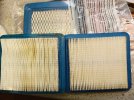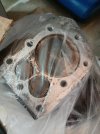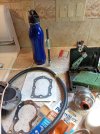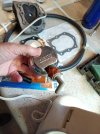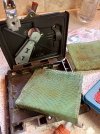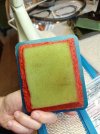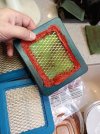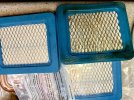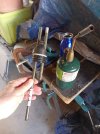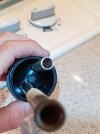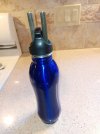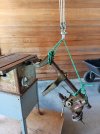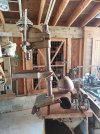MEASURE TWICE
Well-Known Member
I am replying to self as the Nov 13th 2017 post has the info about the intake valve way out of spec.Last week I adjusted the intake valve lash that was out of tolerance. Gap between tappet and valve stem on the intake valve was 0.0015 inches.
The intake specification is to be between 0.005 inches and 0.007 inches.
With grinding the valve stem a bit with sand paper on a porcelain hard surface, I got it level ground after seeing I was going on a tilt at first. Also lapped both intake and exhaust valves in there seats and the result I ended up on target was 0.006 inches in the center or the range for the intake specification.
Saturday was out at Mendocino National Forest again at another location Stonyford. There was for Sunday a Enduro event and left although maybe trails would have some open not for the event. I was also maybe interested in watching, but they said there was not really much any place to see except a few areas. Also weather was supposed to have rain again, but it was clear.
As for my bike not restarting after it was run hard and got hot, this was not happening anymore and worked flawlessly. Only thing the area had also lots of rocky trails and dirt roads, so I found a few paved roads for short distance they allowed, but they are not that interesting. The mud puddles I usually avoided if I could, but near leaving time I went few times right through the center of deep mud puddles. These ones differed from think viscous mud type I had done before. There was maybe 3 inches of water and they 3 inches of viscous stuff underneath.
The past ones I rode through years ago had maybe 5 inches of viscous mud and if you turned the handle bars your sure to take a spill. I did not do that then or this time either. The bike is only 3.5 hp and no match for the very powerful trail bikes there.
Not very many people see a home made trail bike so quite a few people ask questions what is this. I though one person said something who was with a group of people that saw me riding there, it was this one person that said something like about finishing riding or being there the next day in the Enduro event. Only later I though maybe he was feeling I should have been going faster.
Going around banked turns and through mud as well as large rocky surfaces, I can't do as well as more powerful trail bikes. Those bikes have tire width 3 times that of mine.
I had good fun riding and the next day cleaned my riding gear some covered in mud. The bike I will clean some later, but though I did only pay 5 dollars to camp, the riding is paid by my 2 year OHV registration, and I got free under coating on my bike.
I have to shim my helmet cam mount it is at the maximum to point upward, but it misses seeing a lot higher up in view. I guess I am leaning forward and my helmet may be pointed down some. My eyes are looking up and I thought it was going to get good movies.
Maybe I will get that fixed soon, but I will get a link from Vimeo for an upload I am about to do of that road scene where I open the throttle up.
You will not see video here, just see it at Vimeo site.
When you click on the blue area "Watch on Vimeo you will see video.
Back then there was almost no valve lash space between tappet and valve stem bottom.
Gasoline was sucked up from venturi effect the wrong way at the paper air filter making the engine not run till it dried out. The piston on compression stroke had intake valve still staying open for like half the travel during compression.
So, it was about a year and a half ago I bought a cylinder head gasket and I was fairly sure it was valve lash again. I could have just looked at the valve lash and not bothered even taking the head off. But the color of the wet area on the paper air filter was so ingrained in my mind that I felt it was valves out of spec again.
To my surprise when I found that the way I set both intake and exhaust valve lash at 0.010” a bit of extra gap for both valves, was still the same at 0.010”, I though now what.
I inspected the wet yellow area on the paper air filter and it as it turns out is not gasoline but oil mist this time.
Before it was probably both gasoline from valves out of spec and breather oil spray.
The breather actually routes into the throat of the carb, between it and the air filter.
The oil mist I think should not get the paper air filter coated with oil mist. The direction should be primarily just into the carb throat.
Maybe some kind of pressure from the crankcase and turbulence has it go both directions?
Now I have understood that the Briggs engine tilted back about 15 degrees, along with going up some inclines doing motor cross in the woods could make this a need for a catch can.
I have a stainless-steel water bottle with a plastic screw top. I have some brass tubing and rubber automotive OK for fuel / oil and high temp Copper RTV stuff to make the catch can.
I was ready to drill the cap for goes into with the metal tube going nearly to the bottom of the bottle. The goes out just a short piece of tube to have the oil stay at the bottom of the bottle and only mist out the top. Maybe some additional filter to stop the mist of oil and just let fumes by the exit of the bottle to go back into the intake.
The weather was unusually nice for one day and I got a start till now looks like a week of rain. Continuing the work when it is dry again.
Question:
I did mention to a store proprietor about my project and he mentioned about blow by being a cause. I’m not sure if he knew the brings engines of old have a pencil size hole the goes from inside the crankcase by the cam for the tappets and right straight up to where the springs for the valves are and the breather.
Do overhead valve engines besides actually not needing to grinding valve stems to adjust to get gap back, also do not have problem with engine tilt causing oil spray into the carb throat?
I mean the blow by if it was really that bad, then I would probably have the engine being less powerful and less compression maybe too.
I did not notice less power, just a paper air filter that has oil coating about the center third of it in a stripe. Then it would become hard to start and I could get stuck having to replace the air filter just to be able to start the engine again.
MT


